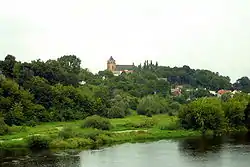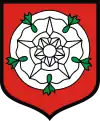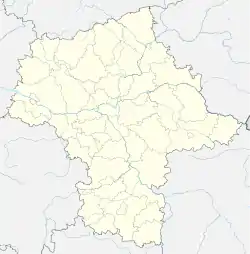Różan
Różan [ˈruʐan] is a town in Mazovian Voivodeship, Poland, on the river Narew. National roads 60 and 61 intersect in the town.
Różan | |
|---|---|
 View with Narew river | |
 Coat of arms | |
 Różan  Różan | |
| Coordinates: 52°53′25″N 21°23′45″E | |
| Country | |
| Voivodeship | |
| County | Maków |
| Gmina | Różan |
| Town rights | 1378 |
| Government | |
| • Mayor | Jerzy Kazimierz Parciński |
| Area | |
| • Total | 6.67 km2 (2.58 sq mi) |
| Population (2006) | |
| • Total | 2,661 |
| • Density | 400/km2 (1,000/sq mi) |
| Time zone | UTC+1 (CET) |
| • Summer (DST) | UTC+2 (CEST) |
| Postal code | 06-230 |
| Area code(s) | +48 29 |
| Car plates | WMA |
| Website | www.rozan.eur.pl |
In the late Middle Ages, Różan emerged as an important trade center of northeastern Mazovia. Enjoying the support of Mazovian Dukes, especially Janusz I of Warsaw, in 1378 it received town charter, and became a capital of a separate province, the Land of Różan. In 1525, Mazovia was annexed by the Kingdom of Poland and Różan became seat of a starosta, part of Masovian Voivodeship (1526–1795). In 1565, the town had 330 houses and a population of about 2000. It also probably had as many as 6 churches, and a castle, which guarded the nearby border with Prussia. Furthermore, there was a bridge over the Narew, which fortified the importance of Rozan as a trade and administrative center.
The town prospered until the disastrous Swedish invasion of Poland (1655–1660), when it was ransacked and burned by the invaders. Following the Partitions of Poland and the Congress of Vienna, Rozan in 1815 became part of Russian-controlled Congress Poland, where it remained until World War One. After the January Uprising, which was widely supported by local residents, in 1870 Russians stripped Różan of its town charter. Nevertheless, Różan was a strong garrison of the Imperial Russian Army, with four forts, built after 1886.
Różan regained town rights in 1919, and by 1939, its population grew to 5800. The town was completely destroyed during World War Two, only 5% of buildings remained by 1945.
The crossing of the Narew at Różan had significant military importance in the first half of the 20th century. The Russian Imperial Army fortified and garrisoned Różan around 1900. The Różan Fortress was built at that time. It was defended against German attacks in 1915 in the course of World War I. Fortified further before 1939, it was defended by the Polish army in the course of the German Invasion of Poland in September, 1939. Then, in the course of the fighting in 1944, the Red Army seized a bridgehead across the Narew at Różan, which it used as one of the springboards for the January 1945 Vistula–Oder Offensive.
At the outbreak of World War Two, Różan was home to some 1,800 Jews. From March of 1942 until September, a slave labor camp for Jews was operated within the Różan Fortress. In November of 1942, the Jews were sent back to the nearby ghetto in Maków Mazowiecki, whereupon they were deported to Auschwitz. Over 1,400 Rozan Jews were murdered in the Holocaust.[1]
References
- "Pinkas Hakehillot Polin: Rozan". www.jewishgen.org.
| Wikimedia Commons has media related to Różan. |
